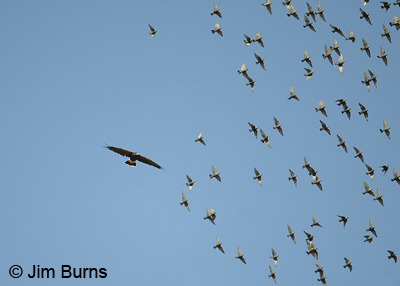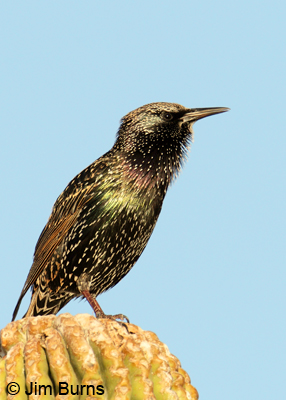
Did anyone else see the huge murmuration of European Starlings captured on video last month by two canoeists in Ireland? A “murmuration of starlings,” like a “murder of crows,” is just one of many colorful names for groups of animals coined in 15th century England, its origins lost in antiquity. The murmuration recorded in Ireland numbered in the thousands, but a little research turned up an English birder remembering murmurations in the millions in London and lamenting that the starling population there has declined by 70% since then. He wrote that there was hope for the species because it seemed to be thriving in North America. As if! For most U.S. birders “starling” is the illustration next to “trash bird” in the book of phrases.
Nonetheless, despite its historical tie to starlings, there’s fascinating scientific explanation for “murmuration.” Each individual in a flock of flying birds tries to stay as far from the edge as possible and as close to its neighbor as possible by mimicking exactly every change in its direction and speed. In species of smaller birds that form large flocks this is a safety/survival technique evolved to thwart flying predators from singling out one individual. The beauty of this technique for the human beholder is the amazing synchronicity of the undulating wave of birds against the backdrop of sky, the larger the flock the more awesome the murmuration.
If you thought you’d never see “starling” and “beauty” in the same paragraph, you should have been on the photo workshop I led to a Valley park a few weeks ago. Late October can be a slow time for birding in the low deserts. Fall migration is definitely over but overwintering species, the real “snowbirds,” haven’t quite arrived yet. But it’s a great time for starlings. We had starlings teeing up on Saguaros, starlings eating date palm fruit, and starlings in small, stringy flocks. We didn’t see a murmuration, but workshop participants were surprised by the beauty of starlings at this season once I made them keep angling up over a rocky hillside until the early morning sunlight was directly behind them and a starling-on-Saguaro directly in front of them.
Starlings go through one molt per year, a prebasic molt, in late summer/early fall, which leaves them speckled white on a black background with some cinnamon edgings on wing and tail feathers and a black bill. The white speckles are crisp chevrons which stand out in sharp contrast to the glossy black which carries an iridescence of green and purple. If you think that sounds spectacular, you’re right. Love them or hate them, European Starlings are beautiful in the fall.
Check out the image below the column. When I saw the bird teed up in the sun I told workshop participants this would be our best photo op of the day. By lunchtime, as we reviewed our images, they agreed I was right. Starling flock size builds through the winter before breeding dispersal in spring. Visit farm fields in the far southeastern or southwestern Valley. You may catch a small murmuration of this beautiful trash bird.
